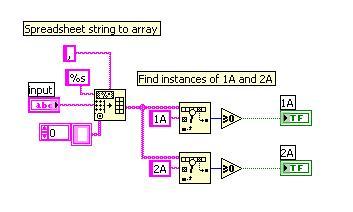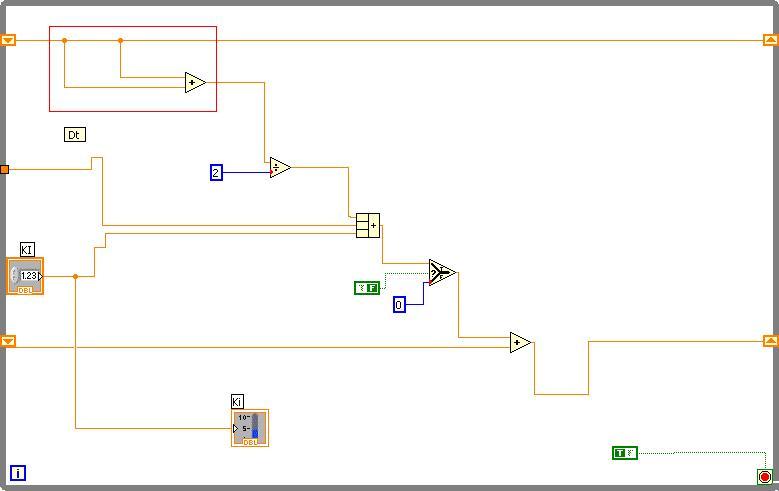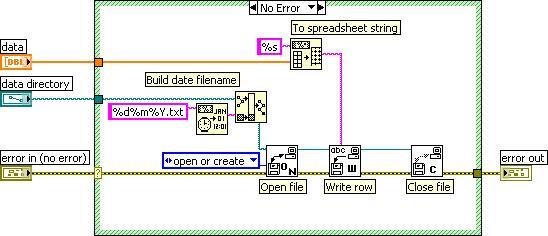-
Posts
253 -
Joined
-
Last visited
-
Days Won
13
Content Type
Profiles
Forums
Downloads
Gallery
Everything posted by Kurt Friday
-
Sure, the following code will do what you want. As I understand if 1A or 2A exist in a comma separated string then light up 1A or 2A if exists.
-
One thing I noticed from looking at your code and comparing it against the paper is that there is an issue in your integrating term as shown in the attached image. Also you are using Add Compound Arithmetic you should be using Multiply Compound Arithmetic Have you also considered using the PID toolkit available from NI?
-

helpe needed! export all data after the loop terminates executing
Kurt Friday replied to ginos's topic in LabVIEW General
There are two ways to do this. 1) Create a measurement task in MAX where you specify the temperature range and other parameters of your measurement and then in LabVIEW perform acquisition using that task. 2) Basically create the task in LabVIEW by using DAQmx Create Channel where you can specify the range of your measurement. I believe in your case you are calling DAQmx Create Channel (AI-Temperature Thermocouple).vi where you do specify the limits and also thermocouple type, cjc source ect so for your case you dont need to jump into MAX to set anything up. -
Just took a look on the NI Instrument driver site and there is a driver for a Uni-Trend UT804 So I'd take a look at that and see how they have implemented the protocol, I suspect it would be similar. Also go to the Uni-Trend site for your model there is some software which you can interface to your multimeter which will allow you to read values etc, its not a driver but the useful thing is that it will give you a reality check, also if you build a serial proxy or sniffer you can then look at the packets going back and forth which will give you some insight into what you need to implement in your own driver. But in the mean time definitely do as Francois has suggested and contact the manufacturer and ask for the protocol.
-

FP.Get Image has strange results for minimized front panels
Kurt Friday replied to John Lokanis's topic in User Interface
Hi John I built the same code in LV 7.1 and you don't see the issue, and its fine in 8.2.2 however at 8.5 you see the behavior you are experiencing. So it looks like a bug. A possible work around may be to build a LV 7.1 dll that does this operation for you. -

How to divide long measurment excel file in day by day
Kurt Friday replied to Ammar's topic in Database and File IO
Sure here it is, done in LV 7.1 LogDat.WriteDaily.vi -

Re-entrant VI with Front Panel
Kurt Friday replied to jgcode's topic in Application Design & Architecture
Ha, cool, didn't recognize you Jon without your Bee Avatar. -
From the album: Kurt's Gallery
Milo when he was a puppy, in one of his less destructive moments. -

Re-entrant VI with Front Panel
Kurt Friday replied to jgcode's topic in Application Design & Architecture
I prefer method 1 What I do instead of waiting in a loop is to pass an occurrence ref into it and then when the spawned vi is loaded it sets the occurrence which is the signal to the launcher that it can continue. Another advantage I like about method 1 is that you can include your vi within your code but have it cased out, so if it's broken you know about it at top level also you don't need to include it as a support file when you build, its already there. One trick you need to be aware of is that LabVIEW will strip the front panel of any vi unless you have the vi property "Show Front Panel When Called" set to true or you have a property node of a control in the code. I don't know the performance advantages of each method though. -
I don't know if it will help at all without seeing the rest of your code but try data flowing those two case structures together, ie left one must complete before right.
-

How to divide long measurment excel file in day by day
Kurt Friday replied to Ammar's topic in Database and File IO
Hi Ammar I think what you want to do can be achieved with a vi like the following. Each time the date changes a new data file is generated. -

creating executables
Kurt Friday replied to bourne identity's topic in Application Builder, Installers and code distribution
Do you have Application Builder or LabVIEW Professional? Have a look in your NI License Manager which you can access from Start Menu >> National Instruments >> NI License Manager have a look at what you have activated. -

GOOP Developer free of charge for commercial use
Kurt Friday replied to Kurt Friday's topic in Announcements
Hi Bjarne The Open Source GOOP Templates that GOOP Developer uses to build classes was developed by SciWare and JKI before LVOOP was around and doesn’t use LVOOP in any form. The differences between the two are. Advantages You can develop OOP systems for RT platforms.Building your system to an exe is really easy, just add your top level vi and then build. Building a system that includes LVOOP is a more complicated process. It’s a by reference implementation, LVOOP is natively is by value, although there are LVOOP frameworks that will give you by reference implantations see Endevo's GOOP Development Suite (GDS). You can create Active Objects, i.e. each instance has its own process running in the background. However there is a Design Pattern in GDS that I contributed to with Mikael Holmström that will allow active objects. You can develop in LabVIEW 6.1 and up.The GOOP Templates are open source under the BSD open source license. Disadvantages You have to be vigilant about keeping your interfaces between parent and child methods the same, there is no development environment mechanism that will warn you, like LVOOP does. You cannot easily shift inheritance from one class to another. In GOOP Developer you build a child from a parent. Super Messaging is more elegantly implemented in LVOOP.You have the ability in LVOOP to make methods private or protected. A method call in LVOOP is faster than that derived from an existing Open Source GOOP Template. -

GOOP Developer free of charge for commercial use
Kurt Friday replied to Kurt Friday's topic in Announcements
I suppose my main reason for doing this is that I get a real kick out of having my software used. Making money out of GOOP developer was never my primary motivation for creating it, it grew out of an interest of mine and then into a passion/obsession, I had tremendous fun developing it and it’s a tool I cant live without and I love it when other developers are using it to build their systems. It’s paid for my LabVIEW licenses over the years and put some change into the beer fund, but the market that this tool appeals too though is quite small, smaller still is the group within that market who can afford the tool or get approval to buy it. About 18 months ago I released GOOP Developer free of charge for academic use because there were people out there who wanted to use it for academic purposes but couldn’t afford or get approval for it, so I thought it would be cool to help them out. Another reason is that GOOP Developer has marketing value, it gets people visiting my site which is important now that I’m working towards becoming an alliance member and concentrating on my development services. -
Hi Everyone Just a heads up that GOOP Developer has recently been released free of charge for commercial use. To obtain a copy just navigate to my site. I'm also toying with the idea of releasing the source code for GOOP Developer under the BSD Open Source License, let me know if you are interested. As you know GOOP Developer uses a lot of scripting to achieve its voodoo. The scripting is performed mostly by agent vi's which are called by the GOOP Developer exe using vi server, if you are interested in having a look under the hood at some of the scripting functionality take a look in the agents folder, the password to unlock them is "scigoop"
-
Hi Everyone I just wanted to mention that GOOP Developer 2.2 is now compatible with LabVIEW 8.6 To upgrade, evaluate or to learn more please visit my site GOOP Developer 2.2 is also available free of charge for academic use which includes teaching and research.
-
Cool, very clever :thumbup:
-

Can an EXE use Active to open LV Development Environment?
Kurt Friday replied to jgcode's topic in Calling External Code
No problem mate Does the code I posted work on your laptop? At the moment I'm not sure what the issue could be, could you post that code you displayed? -

Can an EXE use Active to open LV Development Environment?
Kurt Friday replied to jgcode's topic in Calling External Code
Try this Download File:post-1058-1213255078.zip -

LV8.5, OOP and Embedded Targets
Kurt Friday replied to jgcode's topic in Object-Oriented Programming
Just a couple of updates. 1) The GOOP Template SciWare_JKI_V1R4 is now included in the build. This template resolves a bug with reentrant virtual methods in 8.5 2) All downloads are now zip files. Were previously rar renamed as zip which caused a problem if you tried to use windows zip. -

LV8.5, OOP and Embedded Targets
Kurt Friday replied to jgcode's topic in Object-Oriented Programming
Hi JG I've updated my site and GOOP Developer 2.1 is now compatible with LabVIEW 8.5 To upgrade to GOOP Developer 2.1 Full simply visit the support page and enter the e-mail address you used with your order. -

LV8.5, OOP and Embedded Targets
Kurt Friday replied to jgcode's topic in Object-Oriented Programming
Hi JG Yes classes developed with GOOP Developer will work on RT. I have a version that works with 8.5 that can be released so I'll get moving on that and put an update out soon. -
I promised to use my LabVIEW powers for good, not evil, so I had nothing to do with this. Perhaps this is a sign that there is a market for a Euthanasia toolkit for LabVIEW?
-
Hi John I did a Savitzky Golay smoothing filter some time ago which should help you obtain a smooth 2nd derivative, it might be worth having a play with. http://www.sciware.com.au/freesoftware/index.html Cheers Kurt






